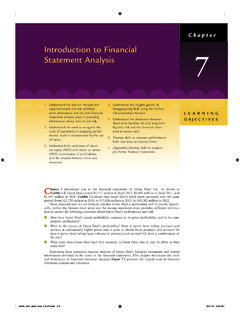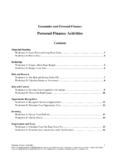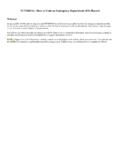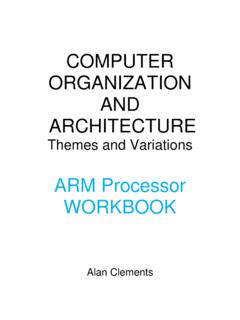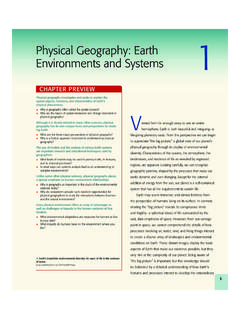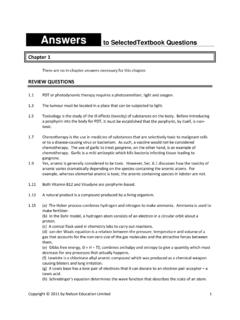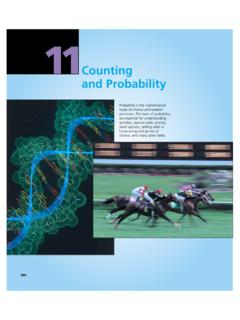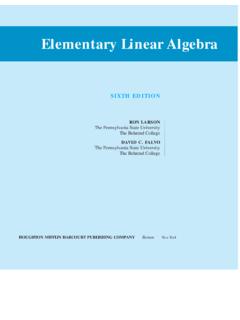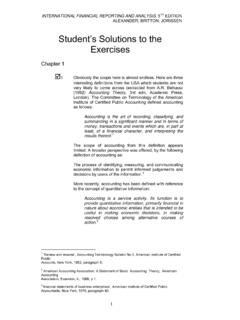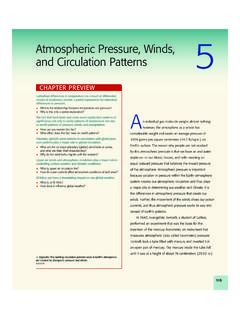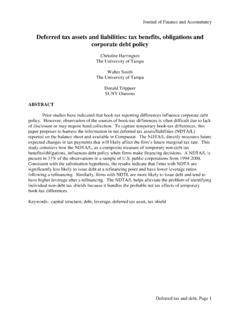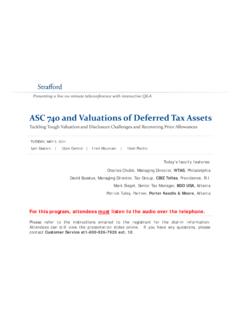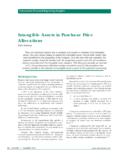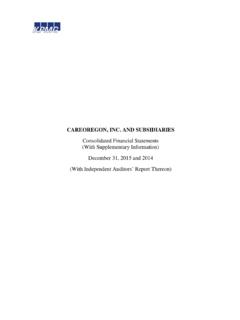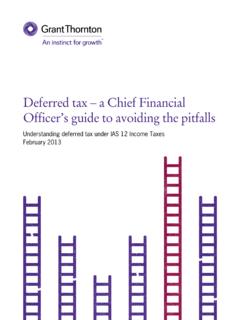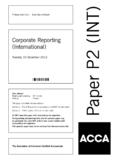Transcription of ACCOUNTING FOR DEFERRED INCOME TAXES - Cengage
1 ACCOUNTING FOR DEFERREDINCOME TAXESLEARNING OBJECTIVEE xtend your understanding of DEFERRED tax ACCOUNTING by incorporating the effects of changes inincome tax rates and in the valuation allowance for DEFERRED tax accepted ACCOUNTING principles (GAAP) require firms measuring their INCOME tax expense to incor-porate the effects of temporary differences between book INCOME and taxable INCOME . INCOME tax expenseeach period equals INCOME TAXES payable for the period plus (minus) the INCOME TAXES that the firm expects to pay(save) in future periods when temporary differences between book INCOME and taxable INCOME INCOME tax expense in this way matches INCOME tax expense with the amount of pre-tax book on TerminologyWe find the correct term INCOME before INCOME TAXES for financial report-ing too cumbersome to use throughout this section. Instead, we use book incometo refer to INCOME beforeincome TAXES reported in the financial statements, and we use taxable incometo refer to the amount reportedin the INCOME tax return.
2 Similarly, the terms book purposesand tax purposesdistinguish the financialstatements from the tax return. We use the term pre-tax incometo refer to an item on the financial state-ments and the term taxable incometo refer to an item on the tax illustration for Burns Corporation in the textbook showed that INCOME tax expense each period equaledpre-tax book INCOME for financial reporting times the INCOME tax rate; in each year, INCOME tax expense was$32,000 (= .40 $80,000). INCOME tax expense also equaled INCOME TAXES currently payable plus the changein the DEFERRED Tax Liability account. For example, INCOME tax expense for Year 1 equals INCOME TAXES cur-rently payable of $30,400 plus the $1,600 increase in the DEFERRED Tax Liability account. INCOME tax expensefor Year 4 equals INCOME TAXES currently payable of $34,240 minus the $2,240 decrease in the DEFERRED TaxLiability account.
3 The DEFERRED Tax Liability account changed each year by the amount of the tax effect ofthe temporary difference between depreciation in the financial statements and on the tax OF DEFERRED TAX ACCOUNTINGThe Financial ACCOUNTING Standards Board (FASB) requires a more complex ACCOUNTING for INCOME taxesthan is shown by the simple illustration for Burns Corporation in Chapter 10, for the following INCOME tax rate that firms will have to pay in the future might change, and if so, the amount in theDeferred Tax Liability account will not represent the amount of TAXES that the firm must pay differences might create DEFERRED tax assets instead of DEFERRED tax liabilities . A DEFERRED taxasset arises when a firm recognizes an expense earlier for financial reporting than for tax reporting. Forexample, a firm expenses an estimate of warranty costs in the year it sells the warranted product, for bookpurposes, but it does not claim a tax deduction until later, when it makes actual expenditures for warrantyrepairs.
4 Similarly, for financial reporting, a firm reports Bad Debt Expense in the year it makes a creditsale, but it does not claim a tax deduction until later, when it writes off specific uncollectible require firms to recognize a valuation allowance (similar in concept to an allowance for uncol-lectible accounts) to reduce the balance in the DEFERRED Tax asset account to the amount the firmexpects to realize in tax savings in the future. A firm with available future tax deductions for warrantycosts or bad debts will not realize the benefits of these tax deductions if it cannot generate positivetaxable INCOME in the future. The valuation allowance adjusts downward the balance in DEFERRED TaxAssets for the uncertainty that the firm will realize these tax benefits. DEFERRED tax liabilities do notrequire a valuation , the DEFERRED Tax asset or DEFERRED Tax Liability accounts on the balance sheet can change eachperiod because differences originating or reversing during the current period (illustrated in the Burnsexample in the textbook); in INCOME tax rates expected to apply in future periods when temporary differences reverse(illustrated in the next section); and in the valuation allowance for DEFERRED Tax Assets (illustrated in the next section).
5 The illustration for Burns Corporation in Exhibit in the textbook assumed that only the first of thethree factors affected DEFERRED INCOME TAXES each year. In such cases, we can measure INCOME tax expenseusing pre-tax INCOME amounts from the financial statements and plug the difference between INCOME taxexpense and INCOME tax payable to DEFERRED asset or liability accounts on the balance the second and third factors often occur, GAAP instead require firms to measure INCOME tax expenseby firstcalculating the required balances in DEFERRED Tax Assets and DEFERRED Tax liabilities at the beginningand the end of each year. Firms then compute INCOME tax expense equal to INCOME TAXES currently payable plus(minus) credit (debit) changes in DEFERRED tax accounts. The required balances in DEFERRED tax accounts on thebalance sheet include (1) cumulative temporary differences, (2) currently enacted tax rates applicable to futurereversals of temporary differences, and (3) current valuation allowances for DEFERRED tax assets.
6 Thus, anychanges in these three items during a period affect the amount of INCOME tax expense for that 1 Exhibit 1 continues the example for Burns Corporation. The top panel shows the compu-tation of the required balance in the DEFERRED Tax Liability account at the end of each year: see column [6].The required balance equals the difference between the tax basis and the financial reporting basis of the equip-ment times the tax rate expected to apply when the temporary differences reverse, a tax rate of 40 percent inthis example. Columns [1] and [2] show the tax basis of the equipment using accelerated [3] and [4] show the financial reporting basis of the asset using straight-line depreciation. Column[5] shows the difference between the tax and the financial reporting bases at the end of each year. At the endof Year 1, the book basis exceeds the tax basis by $4,000.
7 Burns must report a balance of $1,600 (= .40 $4,000) in its DEFERRED Tax Liability account for the extra INCOME TAXES it will pay in future years whenbook depreciation exceeds tax depreciation. At the end of Year 2, the difference in the tax basis and thebook basis of the equipment is $22,400, reflecting cumulative differences in depreciation for the two required balance in the DEFERRED Tax Liability account is $8,960 (= .40 $22,400).The lower panel of Exhibit 1 shows the computation of INCOME tax expense. INCOME tax expense equalsincome TAXES currently payable, column [10], plus (minus) the credit (debit) change in the DEFERRED TaxLiability account from column [11]. Example 2 Assume that, during Year 2, Congress changes the INCOME tax rate applicable to the cur-rent and future years from 40 percent to 30 percent. The required balance in the DEFERRED Tax Liabilityaccount at the end of Year 2 is now $6,720 (=.)
8 30 $22,400). The change in the balance in the DeferredTax Liability account from the end of Year 1 to the end of Year 2 is $5,120 (= $6,720 $1,600). Incometax payable for Year 2 is $18,480 (= .30 $61,600). Thus, INCOME tax expense is $23,600 (= $18,480 +$5,120). In Year 2, we reduce the DEFERRED INCOME tax balance to reflect the expected lower future TAXES ;this reduces INCOME tax expense for Year 2 from the amount it would otherwise have OF REQUIRED ACCOUNTING FOR INCOME TAXESThis section summarizes the required ACCOUNTING for INCOME TAXES . FASB Statement of Financial AccountingStandards No. 1091sets forth the following procedure for computing INCOME tax at each balance sheet date all differences between the book basis and the tax basis of assets for DEFERRED INCOME Taxes21 Financial ACCOUNTING Standards Board, Statement of Financial ACCOUNTING Standards No.
9 109, ACCOUNTING for INCOME TAXES , step 1differences that will have no future tax consequence (that is, eliminate permanent dif-ferences). the remaining differences (temporary differences) into those that will result in future taxdeductions and those that will result in future taxable temporary differences that will result in future taxable INCOME by the enacted INCOME taxrate expected to apply in the future period of the taxable INCOME . Show the result as a DEFERRED tax lia-bility on the balance temporary differences that give rise to future tax deductions by the enacted INCOME tax rateexpected to apply in the future periods of the deductions. Show the result as a DEFERRED tax asset on thebalance sheet; see step 6, the likelihood that the firm will realize the benefits of DEFERRED tax assets in the future. If the firmis more likely than not (that is, the probability exceeds 50 percent) to realize the benefits, thendeferred tax assets equal the amount in step 5above.
10 If the firm has a realization probability of less than50 percent, then the firm must reduce the DEFERRED tax asset by a valuation allowance (similar in conceptto an allowance for uncollectible accounts receivable). The DEFERRED tax asset valuation allowancereduces the DEFERRED tax asset to the amount the firm expects to realize in tax savings in the six-step procedure results in a DEFERRED tax asset and a DEFERRED tax liability at each balance sheet compute INCOME tax expense each period,1. start with INCOME TAXES currently payable on taxable INCOME (the amounts in column [10] of Exhibit1), and (or subtract) the credit (or debit) change in the DEFERRED tax asset and the DEFERRED tax liabilitybetween the beginning and the end of the period (the amount in column [11] of Exhibit 1). This sec-ond component of INCOME tax expense includes temporary differences, changes in enacted INCOME taxrates, and changes in the valuation for DEFERRED INCOME Taxes3 PROBLEM FOR SELF-STUDYC omputing INCOME tax expense and DEFERRED tax book basis and thetax basis of the assets and liabilities of Coniff Corporation on December 31, Year 3, Year 4, and Year 5,appear of DifferenceDateBook BasisTax BasisPermanentTemporaryDecember 31, Year 3 Assets.
